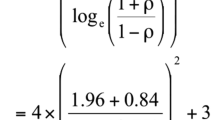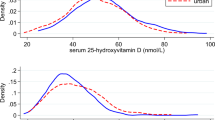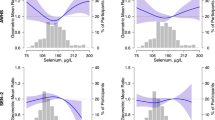Abstract
Aim:
To assess associations of the serum level of 25-hydroxyvitamin D with insulin resistance and β-cell function in a healthy Chinese female population.
Methods:
This cross-sectional study included 1382 female participants free of type 2 diabetes who were recruited in Shanghai. Blood samples were collected within a winter season and the serum levels of 25-hydroxyvitamin D, fasting plasma glucose and insulin, and other biochemical parameters were determined. Insulin resistance and β-cell function were assessed using the homeostasis model assessments of insulin resistance (HOMA-IR) and β-cell function (HOMA-B), respectively.
Results:
Multiple linear regression analyses adjusted for age, parathyroid hormone, Ca2+ and BMI revealed that independent inverse associations existed between the serum level of 25-hydroxyvitamin D and HOMA-IR (P<0.001) and between the serum level of 25-hydroxyvitamin D and HOMA-B (P=0.001).
Conclusion:
Serum vitamin D level is significantly and independently associated with insulin resistance and β-cell function in a healthy Chinese female population.
Similar content being viewed by others
Log in or create a free account to read this content
Gain free access to this article, as well as selected content from this journal and more on nature.com
or
References
Wild S, Roglic G, Green A, Sicree R, King H . Global prevalence of diabetes: estimates for the year 2000 and projections for 2030. Diabetes Care 2004; 27: 1047–53.
Forouhi NG, Luan J, Cooper A, Boucher BJ, Wareham NJ . Baseline serum 25-hydroxy vitamin D is predictive of future glycemic status and insulin resistance: the Medical Research Council Ely Prospective Study 1990–2000. Diabetes 2008; 57: 2619–25.
Mattila C, Knekt P, Mannisto S, Rissanen H, Laaksonen MA, Montonen J, et al. Serum 25-hydroxyvitamin D concentration and subsequent risk of type 2 diabetes. Diabetes Care 2007; 30: 2569–70.
Chiu KC, Chu A, Go VL, Saad MF . Hypovitaminosis D is associated with insulin resistance and beta cell dysfunction. Am J Clin Nutr 2004; 79: 820–5.
Kayaniyil S, Vieth R, Retnakaran R, Knight JA, Qi Y, Gerstein HC, et al. Association of vitamin D with insulin resistance and beta-cell dysfunction in subjects at risk for type 2 diabetes. Diabetes Care 2010; 33: 1379–81.
Pacifico L, Anania C, Osborn JF, Ferraro F, Bonci E, Olivero E, et al. Low 25(OH)D3 levels are associated with total adiposity, metabolic syndrome, and hypertension in Caucasian children and adolescents. Eur J Endocrinol 2011; 165: 603–11.
Nsiah-Kumi PA, Erickson JM, Beals JL, Ogle EA, Whiting M, Brushbreaker C, et al. Vitamin d insufficiency is associated with diabetes risk in Native American children. Clin Pediatr (Phila) 2012; 51: 146–53.
Norman AW, Frankel JB, Heldt AM, Grodsky GM . Vitamin D deficiency inhibits pancreatic secretion of insulin. Science 1980; 209: 823–5.
Ayesha I, Bala TS, Reddy CV, Raghuramulu N . Vitamin D deficiency reduces insulin secretion and turnover in rats. Diabetes Nutr Metab 2001; 14: 78–84.
Kadowaki S, Norman AW . Dietary vitamin D is essential for normal insulin secretion from the perfused rat pancreas. J Clin Invest 1984; 73: 759–66.
Mathieu C, Gysemans C, Giulietti A, Bouillon R . Vitamin D and diabetes. Diabetologia 2005; 48: 1247–57.
Johnson JA, Grande JP, Roche PC, Kumar R . Immunohistochemical localization of the 1,25(OH)2D3 receptor and calbindin D28k in human and rat pancreas. Am J Physiol 1994; 267: E356–60.
Maestro B, Campion J, Davila N, Calle C . Stimulation by 1,25-dihydroxyvitamin D3 of insulin receptor expression and insulin responsiveness for glucose transport in U-937 human promonocytic cells. Endocr J 2000; 47: 383–91.
Gulseth HL, Gjelstad IM, Tierney AC, Lovegrove JA, Defoort C, Blaak EE, et al. Serum vitamin D concentration does not predict insulin action or secretion in European subjects with the metabolic syndrome. Diabetes Care 2010; 33: 923–5.
Rhee SY, Hwang YC, Chung HY, Woo JT . Vitamin D and diabetes in Koreans: analyses based on the Fourth Korea National Health and Nutrition Examination Survey (KNHANES), 2008–2009. Diabet Med 2012; 29: 1003–10.
Lu L, Yu Z, Pan A, Hu FB, Franco OH, Li H, et al. Plasma 25-hydroxyvitamin D concentration and metabolic syndrome among middle-aged and elderly Chinese individuals. Diabetes Care 2009; 32: 1278–83.
Matthews DR, Hosker JP, Rudenski AS, Naylor BA, Treacher DF, Turner RC . Homeostasis model assessment: insulin resistance and beta-cell function from fasting plasma glucose and insulin concentrations in man. Diabetologia 1985; 28: 412–9.
WHO Expert Consultation. Appropriate body-mass index for Asian populations and its implications for policy and intervention strategies. Lancet 2004; 363: 157–63.
Oh JY, Barrett-Connor E . Association between vitamin D receptor polymorphism and type 2 diabetes or metabolic syndrome in community-dwelling older adults: the Rancho Bernardo Study. Metabolism 2002; 51: 356–9.
Liu S, Song Y, Ford ES, Manson JE, Buring JE, Ridker PM . Dietary calcium, vitamin D, and the prevalence of metabolic syndrome in middle-aged and older US women. Diabetes Care 2005; 28: 2926–32.
Pittas AG, Dawson-Hughes B, Li T, Van Dam RM, Willett WC, Manson JE, et al. Vitamin D and calcium intake in relation to type 2 diabetes in women. Diabetes Care 2006; 29: 650–6.
Laaksonen MA, Knekt P, Rissanen H, Harkanen T, Virtala E, Marniemi J, et al. The relative importance of modifiable potential risk factors of type 2 diabetes: a meta-analysis of two cohorts. Eur J Epidemiol 2010; 25: 115–24.
Walter M, Kaupper T, Adler K, Foersch J, Bonifacio E, Ziegler AG . No effect of the 1alpha,25-dihydroxyvitamin D3 on beta-cell residual function and insulin requirement in adults with new-onset type 1 diabetes. Diabetes Care 2010; 33: 1443–8.
Blum M, Dolnikowski G, Seyoum E, Harris SS, Booth SL, Peterson J, et al. Vitamin D3 in fat tissue. Endocrine 2008; 33: 90–4.
Kabadi SM, Lee BK, Liu L . Joint effects of obesity and vitamin D insufficiency on insulin resistance and type 2 diabetes: results from the NHANES 2001–2006. Diabetes Care 2012; 35: 2048–54
Hou X, Jia W, Bao Y, Lu H, Jiang S, Zuo Y, et al. Risk factors for overweight and obesity, and changes in body mass index of Chinese adults in Shanghai. BMC Public Health 2008; 8: 389.
Buyukinan M, Ozen S, Kokkun S, Saz EU . The relation of vitamin D deficiency with puberty and insulin resistance in obese children and adolescents. J Pediatr Endocrinol Metab 2012; 25: 83–7.
Harris SS, Pittas AG, Palermo NJ . A randomized, placebo-controlled trial of vitamin D supplementation to improve glycaemia in overweight and obese African Americans. Diabetes Obes Metab 2012; 14: 789–94.
Poomthavorn P, Saowan S, Mahachoklertwattana P, Chailurkit L, Khlairit P . Vitamin D status and glucose homeostasis in obese children and adolescents living in the tropics. Int J Obes (Lond) 2012; 36: 491–5.
Olson ML, Maalouf NM, Oden JD, White PC, Hutchison MR . Vitamin D deficiency in obese children and its relationship to glucose homeostasis. J Clin Endocrinol Metab 2012; 97: 279–85.
Roislien J, Van Calster B, Hjelmesaeth J . Parathyroid hormone is a plausible mediator for the metabolic syndrome in the morbidly obese: a cross-sectional study. Cardiovasc Diabetol 2011; 10: 17.
Fuleihan GE, Deeb M . Hypovitaminosis D in a sunny country. N Engl J Med 1999; 340: 1840–1.
Arunabh S, Pollack S, Yeh J, Aloia JF . Body fat content and 25-hydroxyvitamin D levels in healthy women. J Clin Endocrinol Metab 2003; 88: 157–61.
Chiu KC, Chuang LM, Lee NP, Ryu JM, McGullam JL, Tsai GP, et al. Insulin sensitivity is inversely correlated with plasma intact parathyroid hormone level. Metabolism 2000; 49: 1501–5.
Reis JP, von Muhlen D, Kritz–Silverstein D, Wingard DL, Barrett-Connor E . Vitamin D, parathyroid hormone levels, and the prevalence of metabolic syndrome in community-dwelling older adults. Diabetes Care 2007; 30: 1549–55.
Yamaguchi T, Kanazawa I, Takaoka S, Sugimoto T . Serum calcium is positively correlated with fasting plasma glucose and insulin resistance, independent of parathyroid hormone, in male patients with type 2 diabetes mellitus. Metabolism 2011; 60: 1334–9.
Tai K, Need AG, Horowitz M, Chapman IM . Vitamin D, glucose, insulin, and insulin sensitivity. Nutrition 2008; 24: 279–85.
Timms PM, Mannan N, Hitman GA, Noonan K, Mills PG, Syndercombe-Court D, et al. Circulating MMP9, vitamin D and variation in the TIMP-1 response with VDR genotype: mechanisms for inflammatory damage in chronic disorders? QJM 2002; 95: 787–96.
Acknowledgements
This study was supported by the National Natural Science Foundation of China (81070692, 81000360, and 81170803), the Program of the Shanghai Subject Chief Scientist (08XD1403000) and Science and Technology Commission of Shanghai Municipality (10DZ1950100), Academic Leaders in Health Sciences in Shanghai (XBR2011014) and Shanghai Leading Talent Plan (051).
Author information
Authors and Affiliations
Corresponding author
Rights and permissions
About this article
Cite this article
Tao, Mf., Zhang, Z., Ke, Yh. et al. Association of serum 25-hydroxyvitamin D with insulin resistance and β-cell function in a healthy Chinese female population. Acta Pharmacol Sin 34, 1070–1074 (2013). https://doi.org/10.1038/aps.2013.13
Received:
Accepted:
Published:
Issue date:
DOI: https://doi.org/10.1038/aps.2013.13
Keywords
This article is cited by
-
Association between serum 25-hydroxyvitamin-D and Triglycerides-Glucose index among Indian adolescents
BMC Nutrition (2022)
-
Effect of vitamin D on biochemical parameters in polycystic ovary syndrome women: a meta-analysis
Archives of Gynecology and Obstetrics (2017)
-
Serum vitamin D is associated with non-alcoholic fatty liver disease in Chinese males with normal weight and liver enzymes
Acta Pharmacologica Sinica (2014)
-
Serum osteocalcin levels are inversely associated with plasma glucose and body mass index in healthy Chinese women
Acta Pharmacologica Sinica (2014)



